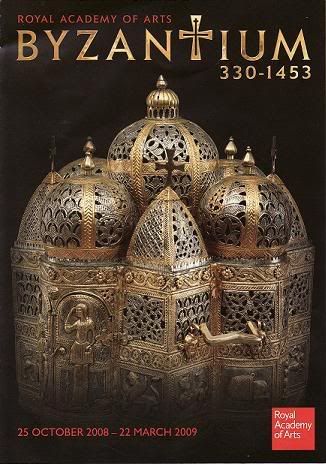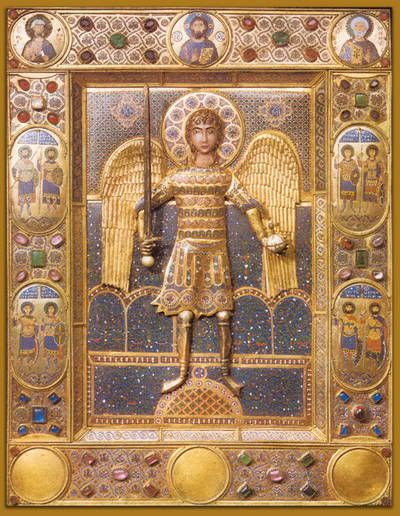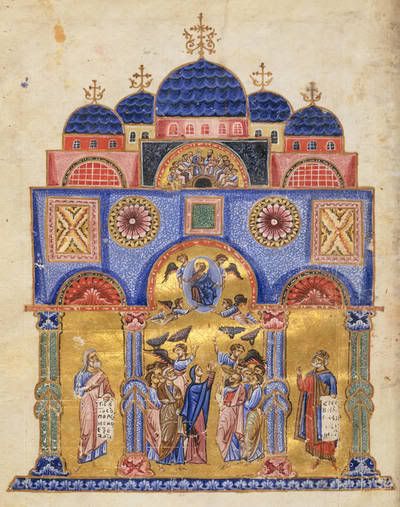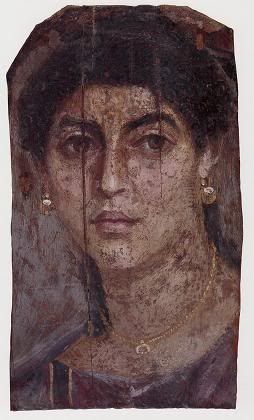
Incense burner in the shape of a church,
gilded silver, 12th century
When I arrived in London for a brief post-Christmas holiday, I learned that the Royal Academy was presenting a special exhibition of the art of Byzantium (modestly renamed Constantinople by the emperor Constantine), which has become synonymous with the Eastern Roman Empire that survived a thousand years after Rome itself fell off the edge of history. The exhibit went on my short list of things to see, and after a night's recovery from the degradation of economy class air travel, I headed straight to the historic Academy building in Piccadilly.
The half dozen or so rooms where the objects are displayed have been sensitively lit -- very subdued overhead lighting, only the art itself clearly visible. This creates an aura of mystery in keeping with the other-worldly spirit of the works, and although the space was crowded, visitors seemed to catch the mood and mostly spoke in near whispers.
The subjects of the pictorial art are familiar: they would become central to the painting and sculpture of the European middle ages. But this is Christian iconography with a difference. The Eastern love of ornament in rich colors, precious metals, and jewels dazzles the eye. No puritanical simplicity here.

Ikon of Archangel Michael
The half dozen or so rooms where the objects are displayed have been sensitively lit -- very subdued overhead lighting, only the art itself clearly visible. This creates an aura of mystery in keeping with the other-worldly spirit of the works, and although the space was crowded, visitors seemed to catch the mood and mostly spoke in near whispers.
The subjects of the pictorial art are familiar: they would become central to the painting and sculpture of the European middle ages. But this is Christian iconography with a difference. The Eastern love of ornament in rich colors, precious metals, and jewels dazzles the eye. No puritanical simplicity here.

Ikon of Archangel Michael
The spectacular elements in the religious art are intended to convey through the senses the transcendent beauty of a greater Reality than we normally know in our earthly lives. Gold was the closest they could come to suggesting Heaven's radiance.
But it's hard to doubt that the people of this Middle Eastern Rome loved brilliant materials for their own sake. The jewelry and faded remnants of costumes that make up part of the show accord very well with the mosaic portraits that have survived of those magnificent show-offs like the emperor Justinian and his empress Theodora (6th century).
In its more prosperous days -- the civilization had its ups and downs, of course -- Byzantium could well afford its flamboyance. Justinian didn't do things by halves in filling his territory with wonders of art and architecture. Will Durant writes:
Several pictures are made in a technique called micro-mosaic, which I had never even heard of. Mosaics are decorations or illustrations made entirely of fragments of colored stones, glass, and jewels; for those meant to adorn walls, the constituent bits (tesserae) are usually about thumbnail size. But the micro-mosaics are pieced together with tesserae almost as tiny as sewing stitches. The finished pieces are like cloth woven entirely of jewels.

Illuminated manuscript on parchment,
12th century
wooden mummy case, A.D. 55-70
But it's hard to doubt that the people of this Middle Eastern Rome loved brilliant materials for their own sake. The jewelry and faded remnants of costumes that make up part of the show accord very well with the mosaic portraits that have survived of those magnificent show-offs like the emperor Justinian and his empress Theodora (6th century).
In its more prosperous days -- the civilization had its ups and downs, of course -- Byzantium could well afford its flamboyance. Justinian didn't do things by halves in filling his territory with wonders of art and architecture. Will Durant writes:
He began now one of the most ambitious building programs in history: fortresses, palaces, monasteries, churches, porticoes, and gates rose throughout the Empire. In Constantinople he rebuilt the Senate House in white marble, and the Baths of Zeuxippus in polychrome marble; raised a marble portico and promenade in the Augusteum; and brought fresh water to the city in a new aqueduct that rivaled Italy's best. He made his own palace the acme of splendor and luxury: its floors and walls were made of marble; its ceilings recounted in mosaic brilliance the triumphs of his reign, and showed the senators "in festal mood, bestowing upon the Emperor honors almost divine." And across the Bosporus, near Chalcedon, he built, as a summer residence for Theodora and her court, the palatial villa of Herion, equipped with its own harbor, forum, church, and baths.Most of the large-scale artistic and architectural achievements of Byzantium have vanished or are in ruins (although the great cathedral of St. Sophia survives, as a mosque). But the collection at the Royal Academy includes some flabbergasting examples of craftsmanship.
Several pictures are made in a technique called micro-mosaic, which I had never even heard of. Mosaics are decorations or illustrations made entirely of fragments of colored stones, glass, and jewels; for those meant to adorn walls, the constituent bits (tesserae) are usually about thumbnail size. But the micro-mosaics are pieced together with tesserae almost as tiny as sewing stitches. The finished pieces are like cloth woven entirely of jewels.

Illuminated manuscript on parchment,
12th century
I don't know what it's doing there, but the Byzantium exhibit includes one of those portraits from North Africa in the heyday of the original Roman Empire that were painted on the coffins of the deceased. They are particularly fascinating because they are, as far as I know, the only surviving paintings of that era meant to represent what specific people actually looked like. The dry air of the region is said to have preserved the wood and paint that would long since have decayed elsewhere.
Roman portrait on cover of wooden mummy case, A.D. 55-70
These paintings, especially of the women, tend to look startlingly modern. As far as what is pictured of the lady above, she would not have been out of place as a spectator in the Royal Academy exhibit.
For all its longevity, Byzantium eventually weakened, for the usual reasons -- unstable politics, religious upheavals (it went through its own period of iconoclasm), and wars that drained its treasury and its best genes. Constantinople was even trashed by its fellow Christians in the fourth Crusade. The West was always suspicious of Byzantium and dithered about sending aid in times of greatest danger, including the last, when Constantinople was besieged by the Ottoman Turks. In 1453, this last descendant of Rome fell to Islam. Sic transit gloria mundi. (I don't know the Greek equivalent, but it would be more appropriate, because the Byzantines were not long in dropping the Latin which few of them could speak well and adopting Greek as the language of their empire.)
Inevitably, but appropriately, the explanatory signage in the exhibition rooms at the Royal Academy quotes from Yeats's "Sailing to Byzantium":
For all its longevity, Byzantium eventually weakened, for the usual reasons -- unstable politics, religious upheavals (it went through its own period of iconoclasm), and wars that drained its treasury and its best genes. Constantinople was even trashed by its fellow Christians in the fourth Crusade. The West was always suspicious of Byzantium and dithered about sending aid in times of greatest danger, including the last, when Constantinople was besieged by the Ottoman Turks. In 1453, this last descendant of Rome fell to Islam. Sic transit gloria mundi. (I don't know the Greek equivalent, but it would be more appropriate, because the Byzantines were not long in dropping the Latin which few of them could speak well and adopting Greek as the language of their empire.)
Inevitably, but appropriately, the explanatory signage in the exhibition rooms at the Royal Academy quotes from Yeats's "Sailing to Byzantium":
... I have sailed the seas and come
To the holy city of Byzantium.
Once out of nature I shall never take
My bodily form from any natural thing,
But such a form as Grecian goldsmiths make
Of hammered gold and gold enamelling
To keep a drowsy Emperor awake;
Or set upon a golden bough to sing
To lords and ladies of Byzantium
Of what is past, or passing, or to come.
To the holy city of Byzantium.
Once out of nature I shall never take
My bodily form from any natural thing,
But such a form as Grecian goldsmiths make
Of hammered gold and gold enamelling
To keep a drowsy Emperor awake;
Or set upon a golden bough to sing
To lords and ladies of Byzantium
Of what is past, or passing, or to come.



No comments:
Post a Comment